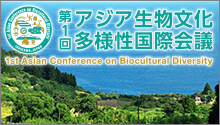UNU-IAS collaboration with Kanazawa City, Japan on the Sustainable Development Goals (SDGs) contributed to the selection of the city as an “SDGs Future City 2020” and a “Municipal SDGs Model Project” in July 2020, under a scheme of the Government of Japan. The goal is to create a sustainable city where citizens and visitors can share in the beauty of the city based on biological and cultural diversity such as nature, history, and culture, while the number of tourists increases.
The UNU-IAS Operating Unit Ishikawa / Kanazawa (OUIK), located in Kanazawa City, has been working with the city to achieve the SDGs, starting with the SDGs Ishikawa–Kanazawa Dialogue Series in 2018. A joint declaration was signed in March 2019 between Kanazawa City, the Junior Chamber of Commerce of Kanazawa, and UNU-IAS OUIK, launching the Kanazawa SDGs project “IMAGINE KANAZAWA 2030”. In order to deepen understanding of the SDGs and regional issues, the “SDGs Café Series” was initiated as a forum for communication where local people can easily talk about the future of Kanazawa and regional issues, and “SDGs Meetings” held to discuss regional issues. UNU-IAS OUIK worked with various local stakeholders to create the “Kanazawa Future Scenario” by exchanging ideas.
“Environmental Model Cities” and “Environmental Future Cities” of Japan
In 2008, the Japanese Government adopted a system to select “Environmental Model Cities” and “Environmental Future Cities” with the aim of achieving a sustainable economy and society. Kanazawa City was selected as an “SDGs Future City” in addition to the “Model Cities for the Environment” and “Future City for the Environment” to propose initiatives to achieve the SDGs with the aim of further promoting regional development. Up to 30 cities each year have been selected since 2018, and in Ishikawa Prefecture, Suzu City (FY2018), Hakusan City (FY2018), Komatsu City (FY2019), and this year Kaga City, Nomi City, and Kanazawa City were newly selected. Kanazawa City is the first municipality in the prefecture to be selected as a “Municipal SDGs Model Project”. These cities were selected based on an evaluation in terms of SDG 17, and are expected to proactively develop their projects to achieve the goals.
Future Plans
OUIK will continue to collaborate with Kanazawa City and the Junior Chamber of Commerce of Kanazawa on a variety of activities such as raising awareness and publicising the SDGs and building a community of co-creation based on the cooperative framework. In particular, in developing attractive SDGs tours, which is an important element of the model project, UNU-IAS OUIK will make use of its practical experience in workshops and other activities to consider “Japanese Gardens and the Sustainability of Kanazawa” and the results of its research on the Noto’s Satoyama Satoumi GIAHS (Globaly Important Agricultural Heritage System) and Mount Hakusan Biosphere Reserve, which have been cultivated through OUIK’s research over the years. UNU-IAS OUIK will provide advice on how to make use of green infrastructure for tourism and SDGs tourism in the wider region.




